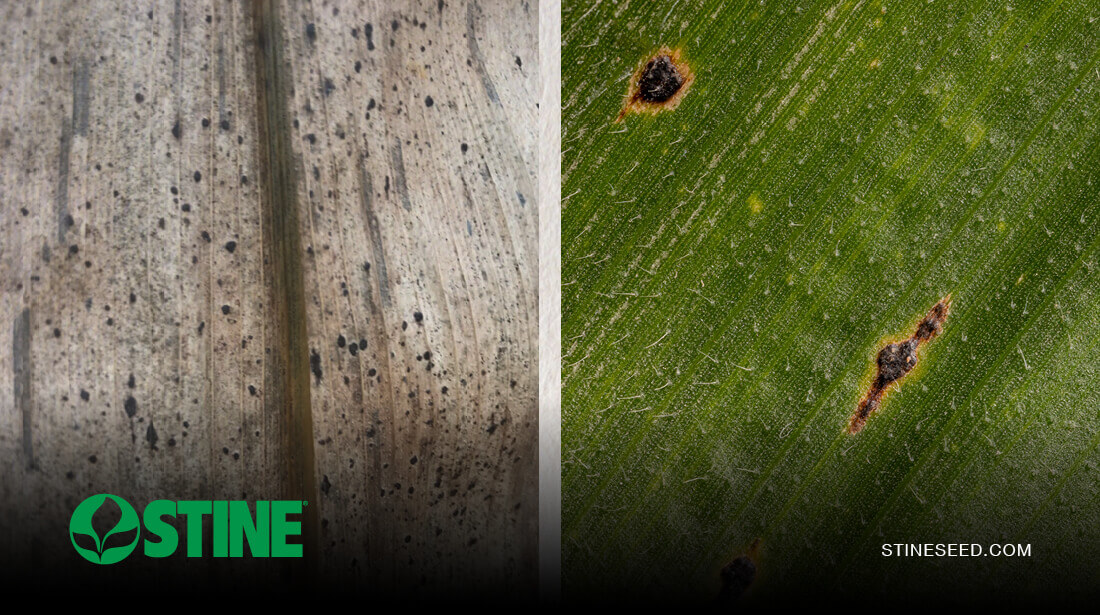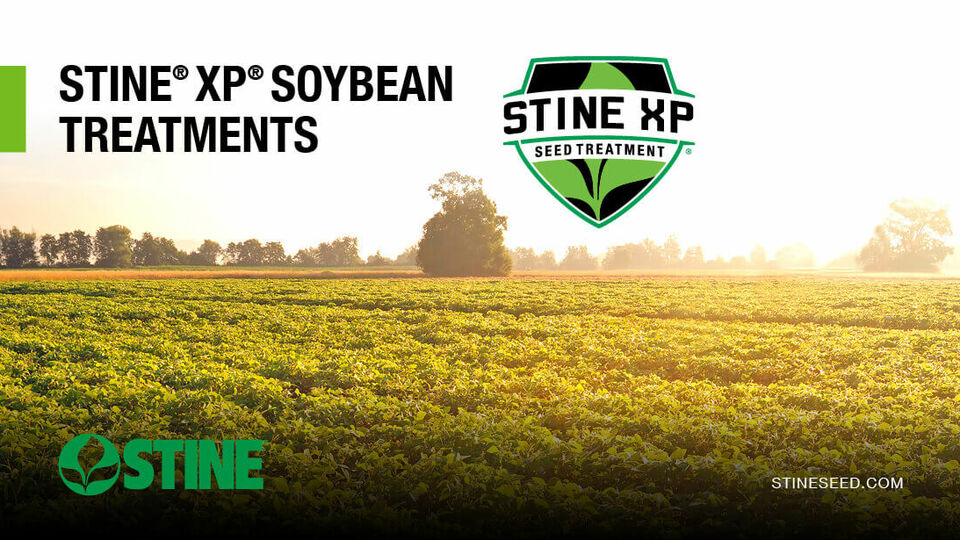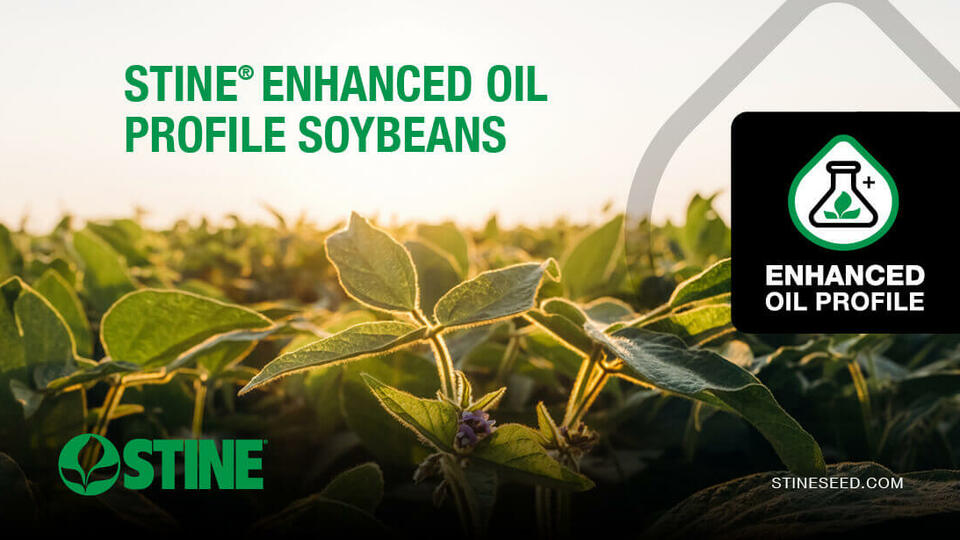Tar spot has reemerged across the Corn Belt, and we’re already helping customers scout, assess risk and make timely management decisions. As a company built on agronomic expertise and in-field data, we understand the importance of being proactive against this aggressive disease.

“Tar spot is a challenge that’s not going away. But we’ve learned a lot about how to manage it, and that comes down to scouting early, timing fungicide applications correctly and selecting hybrids with strong tolerance.”
Tony Lenz, Stine Technical Agronomist
What to look for and when to act
Tar spot is caused by the fungus Phyllachora maydis and typically begins as small, raised black lesions (called stromata) on the leaves. These spots don’t rub off and can spread quickly in cool, wet and humid conditions, especially if your area experiences extended leaf wetness (over seven hours) and humidity over 75%. Tar spot can spread through rain and wind, so the fungal spores are extremely mobile.
In a recent episode of the “Stine Seedcast,” Dr. Darcy Telenko, associate professor and field crop pathologist at Purdue University, shared her expertise on tar spot and what growers should be on the lookout for this growing season.
“That black spot is the fungal fruiting body that’s forming,” says Dr. Telenko. “And if you look at that spot, it’s actually consumed all that leaf material between those two areas … As more and more of those spots take up the leaf, and we go from like one or two spots to 5% of that leaf having stromata on it, that’s a lot of leaf tissue that’s being consumed. So, what it’s doing, it’s using up the photosynthetic area of our corn, and then that’s what’s leading to the yield impacts.”
Tar spot can range in severity, but in extreme cases, it can cause significant yield loss if not properly managed. Growers should be in the fields now scouting for the disease in their lower canopies. For example, Dr. Telenko’s team is concentrating scouting efforts in fields with a previous history and in areas where the disease might start first, like in the edges near a tree line. They report county-level findings and confirmed diagnostic clinic samples on the Crop Protection Network’s Tar Spot of Corn Map to show where the disease is active.
Lenz recommends that scouting continues up until corn reaches the R6 growth stage, and particularly when local weather conditions favor disease development.
“If you’re seeing raised black specks on the leaves, it’s time to track it closely and start preparing your fungicide plan if conditions warrant an application.”
Tony Lenz, Stine Technical Agronomist
Timing is everything
By now, growers should be aware of any tar spot in their fields and be monitoring it weekly to determine if an in-season management strategy makes sense.
“We’re starting to find our first tar spot lesions in the canopy, but there’s still time to make a decision,” notes Dr. Telenko.
She adds that just because we find tar spot, doesn’t mean we spray it right away. It’s important to look at the severity of the disease and the growth stage of the crop before a fungicide is considered.
One potential risk with tar spot is applying fungicide too early. The best return on investment comes from treatments at tassel through early reproductive stages — usually VT to R4, according to Lenz. Spraying too early could result in the need for a second pass before disease pressure peaks. Time the application so it provides the best protection during grain fill.
“There are a lot of great products out there, including fungicides with multiple modes of action that have proven to be effective against tar spot,” says Lenz.
Lenz also reminds growers that tar spot doesn’t always require a fungicide.
“You don’t treat just because it’s been spotted in the county. You treat when conditions and pressure warrant it. That’s where local knowledge and working with your Stine rep make all the difference.”
Tony Lenz, Stine Technical Agronomist
Dr. Telenko notes that the Crop Protection Network offers helpful resources on tar spot, including fungicide efficacy and ratings to help growers find the best application for their situation and guidance for getting ahead of the disease in the future, including tips on hybrid selection.
The advantage of Stine hybrids
At Stine, we don’t just talk about tar spot: We test for it. Many of our Product Development Plot locations include hybrid disease tolerance studies, and our agronomists evaluate real-time pressure throughout the season to guide recommendations for every region we serve.
While fungicide can be a valuable tool, prevention starts with smart hybrid selection.
“We’ve got hybrids in the Stine lineup that show strong tolerance to tar spot,” Lenz says. “Your local Stine rep can help you place those products where they’ll thrive and hold up under stress.”
Dr. Telenko agrees that choosing the right hybrids will play a critical role in the future of tar spot.
“If you can have a hybrid that’s minimizing the disease development in that canopy, then we’ll be less reliant on the fungicides to protect it later on.”
Dr. Darcy Telenko, associate professor and field crop pathologist at Purdue University
Want to stay ahead of tar spot?
Talk with your local Stine representative about hybrid placement and midseason fungicide timing. For more field-tested agronomic insights, visit StineSeed.com.
Related Articles
-

Start strong with Stine®: Maximizing your 2026 potential
January 2026 in Agronomy
-

Stine® to offer Syngenta’s Victrato® soybean seed treatment in 2026
December 2025 in Agronomy
-

Use Stine’s XP® seed treatments to prevent early injury to your crops
December 2025 in Agronomy
-

Understanding Stine’s enhanced oil profile soybeans
December 2025 in Agronomy



